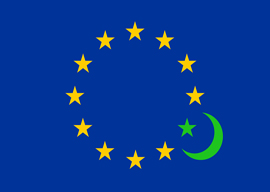
December 18, 2017

Source: Bigstock
It’s that time of the year again. As Coca-Cola’s magic truck trundles across our televisions and Starbucks’ ubiquitous red cups punctuate the daily commute, the terror alerts are flooding in. On Saturday, a knifeman was shot at Schipol Airport in Amsterdam. Two weeks before, elements of a nail bomb were found at Berlin’s Potsdam Christmas market. Last week, a Bangladeshi-Brooklyner detonated a homemade pipe bomb in the subway. The New York Times soft-soaped in spectacular style, telling us the bomber was a “good guy” who had been “radicalized online” and—wait for it—got into neighborhood parking disputes. Just your regular guy next door!
European Christmas markets are now encircled by concrete-and-steel countermeasures against vehicle attacks. Some municipalities have thoughtfully decorated these with Christmas trees, provoking a sardonic Twitter backlash. The police are on a hair-trigger response, recently placing London’s Black Friday on lockdown in response to a rumor. Shoppers ran for their lives—from nothing. If the purpose of terror is to terrorize, then it has succeeded.
Repackaging the ideology behind recent attacks has become an urgent imperative for Western liberals. At the core of this discourse is extrapolating secular motivations from divine ones. And so we are told that terrorism is rooted in foreign policy, poverty, disenfranchisement, racism, prejudicial Islamophobia, Israeli self-determination, and—of course—Donald Trump. If you believe the old adage “Don’t talk down to a man with a gun,” the relentless Western rationalization of jihad must be infuriating to its exponents. Not only infuriating but dangerous, as ignoring the self-professed motivation of those whose only recourse is to violence can only lead to more violence.
The need for a secular West to shoehorn religious terrorism into its own frame of reference extends even to terror’s most outright critics. Their go-to sound bite is that most Eurocentric term, “Islamofascism.” Sure, it’s attention-grabbing and accessible: Who doesn’t hate Nazis? Even Christopher Hitchens did his bit to popularize the comparison. For many writers like him who started their journey on the left, Fascism remains the sine qua non of negative dog whistles. Perhaps this is why—if we are really so in need of a secular cipher for Islamism—the more logical phrase of Islamo-Communism has not proffered itself.
What Islam and Communism share—and Fascism lacks—is the pretense to altruism. Both claim to be the universal solution for all mankind, offering peace at the barrel of a gun. For all its iniquities, Fascism was at least honest about its violent purpose: elevating certain groups to the fatal exclusion of others. From that watershed of candor flow the following four streams of difference.
First: Because Fascism did what it said on the tin, it did not share the others’ reliance on the Big Lie. Stalin’s heavily fortified “Frontier of Peace”—known to us as the Iron Curtain—echoes the historical Islamic distinction between the House of Peace (Muslim lands) and the House of War (everyone else). The “Anti-Imperialist” expansionism of contemporary Islamist terror is also reminiscent of the USSR’s “Anti-Imperialist Empire.” Both further employ peaceful forms of address —brother, sister —within militarized societies. The Nazis got straight to the point with “Hail victory.”
Second: Because of their claim to intellectual totality, Islamism and Communism suppress the power of the individual rather than harnessing it. Private inquiry and commerce—the lifeblood of development—are extinguished. As a result, their economies become extractive rather than innovative. The free-extracting Ottoman Empire could only survive while expanding; thereafter, it declined into poverty. The USSR was famed for having its “windows open in winter,” consuming but not creating. It is ironic—daresay hopeful—that both Communist and Islamist governments will always deny themselves the stability they crave for this reason. Yet Fascism looked eagerly to the power of the private sector to advance its cause—as the awkwardness of certain German industrial families testifies to this day.
Third, which is closely related; The super-primacy of ideology in Communist and Islamist systems creates a fatal drive toward self-purification. This point was illustrated in Graeme Wood’s seminal 2015 article on ISIS, which revealed a readiness to point the finger of heresy at unlucky members. Executing people “to be on the safe side” is also more than familiar to historians of the USSR. Solzhenitsyn’s humor is never darker than when following Stalin’s thoughts as he stalks his bunker. “Someone has killed all the good people,” thunders the Red Tsar to himself, “and it’s left to me to deal with all the rest!” In Arthur Koestler’s Darkness at Noon, a lifelong Party loyalist finds that his time has come. Imprisoned and awaiting execution, he ponders whether this was inevitable , undoubtedly also a common reflection among shamed Islamists. Under the Ottomans, it was a given that the strangler’s rope awaited anyone who served the Sultan not only badly—but also too well.